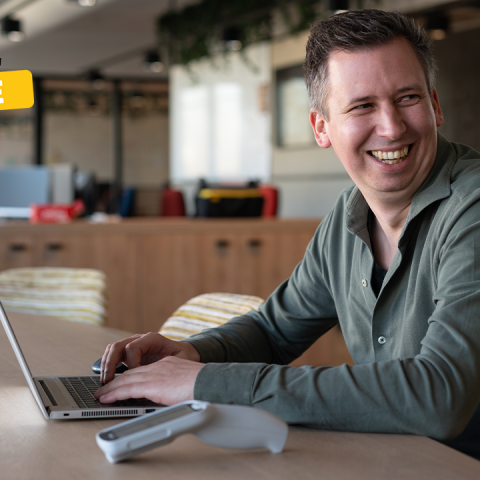
The future of the Jumbo Scanner
How can a hand scanner in a supermarket help enrich the customer experience, detect if a customer made a mistake, or if something else is going wrong? The Jumbo hand scanners hold the potential to do much more than what they are being used for currently. When it comes to functionalities, scanning groceries is just the beginning.
Making shopping for groceries smarter
The Jumbo self-scanners help customers shop for groceries quickly and easily. That’s their basic functionality, but the devices have so much more to offer. An example: specialists at Jumbo’s Tech Campus are currently connecting the Jumbo Extra’s Loyalty program to the scanners’ functionality. Users will soon see personalized discounts and the points they earn in real time.
Shopping without stopping
One of these specialists is Nick Van Rooij, product owner sales and e-commerce. According to him, they are just scratching the surface when it comes to all the possibilities the scanners have to offer: “One of the things I would love to see happening is a connection to a payment system where you complete the transaction when you put the scanner back in its charger.”
“But before we can offer a shopping experience like that, we must build in checks to make sure that we know exactly what the customer bought. There are other stores that use several techniques to achieve that, like cameras. But we feel they would make the customer feel uncomfortable, so those are not an option.
Smart uses for increasingly smarter technology
Technology now is much smarter than it was a few years ago. The same goes for the Jumbo scanners, which opens roads to completely new and very useful applications.
Currently, Jumbo uses sampling to check if people missed items while scanning. Nick: “This is currently done randomly, but we’re looking for smarter ways. For example: when we see a lot of identical scans in a short time, you may have pressed the + button too often. With smarter sampling we would help ourselves and our customers. The scanners can help us determine what requires our attention.”
The fine line
“There is a fine line between what you could do with a scanner and what you should do”, Nick tells us: “In theory, the scanner could see when you’re close to a certain soft-drink brand. It could show a commercial for that brand and offer you a discount. However commercially interesting that may be, it is also very intrusive. This is technology in the hands of our customers, and we look at functionalities through their eyes. So, we would most likely pass on offers to implement something like this.”
It’s discussing these kinds of possibilities with other departments and colleagues that makes his job and his department so interesting, according to Nick. “As a product owner, I collect all business wishes and requirements for new functionalities. I discuss them with IT consultants. And then it is down to me to prioritize the new functionalities and decide if and in which future release we will implement them. I have a significant say in what can be done or not. “
On location
“Whenever I can I visit a store to see our work in action and to listen to what my colleagues have to say about it. With departments like marketing making requests for new functionalities, it’s good to have a direct line to the people and stores that use the scanners every day. Otherwise, we would keep adding new features when all the stores want is to have an existing functionality fixed or improved upon.”
Machines vs people
Quite often an increasing amount of automation causes people to be let go. Nick shakes his head: “That is not our intention at all. People are at the heart of our supermarkets. So, when we can move employees away from processes like checking out, they can spend more time helping customers. After all, this is a people’s business. Technology is here to support us. Not to take over.”
Would you like to join our team of people? Check out our vacancies
